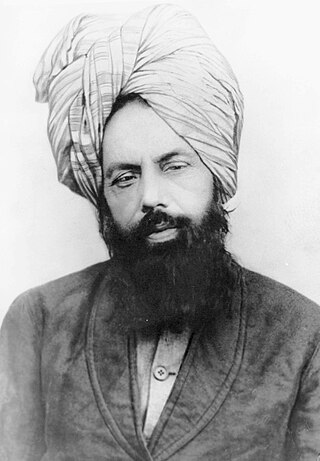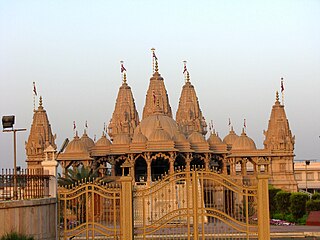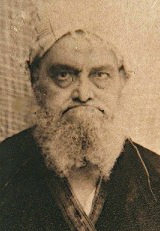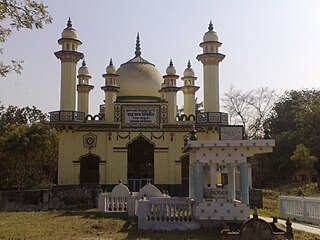The Fatimid dynasty was an Arab dynasty that ruled the Fatimid Caliphate, between 909 and 1171 CE. Descended from Fatima and Ali, and adhering to Isma'ili Shi'ism, they held the Isma'ili imamate, and were regarded as the rightful leaders of the Muslim community. The line of Nizari Isma'ili imams, represented today by the Aga Khans, claims descent from a branch of the Fatimids. The Alavi Bohras, predominantly based in Vadodara, also claim descent from the Fatimids.

Mirza Ghulam Ahmad was an Indian religious leader and the founder of the Ahmadiyya movement in Islam. He claimed to have been divinely appointed as the promised Messiah and Mahdī—which is the metaphorical second-coming of Jesus (mathīl-iʿIsā), in fulfillment of the Islamic prophecies regarding the end times, as well as the Mujaddid of the 14th Islamic century.
Zikrism is a Mahdist minority Muslim group or sect found primarily in the Balochistan region of western Pakistan. The name Zikri comes from the Arabic word Dhikr.

Bharuch, formerly known as Bharutkutccha, is a city at the mouth of the river Narmada in Gujarat in western India. Bharuch is the administrative headquarters of Bharuch District.

Sayyid Muhammad al-Mahdi al-Mauood Jaunpuri was a Muslim mystic and self-proclaimed Mahdi who founded the breakaway Mahdavia sect. Hailing from Jaunpur, Uttar Pradesh, Jaunpuri traveled extensively throughout India, Arabia and Khorasan.
The Musta‘lī are a branch of Isma'ilism named for their acceptance of al-Musta'li as the legitimate nineteenth Fatimid caliph and legitimate successor to his father, al-Mustansir Billah. In contrast, the Nizari—the other living branch of Ismailism, presently led by Aga Khan IV—believe the nineteenth caliph was al-Musta'li's elder brother, Nizar. Isma'ilism is a branch of Shia Islam.
The Sulaymani branch of Tayyibi Isma'ilism is an Islamic community, of which around 70,000 members reside in Yemen, while a few thousand Sulaymani Bohras can be found in India. The Sulaymanis are sometimes headed by a Da'i al-Mutlaq from the Makrami family.

An Islamic flag is the flag either representing an Islamic Caliphate, religious order, state, civil society, military force or other entity associated with Islam. Islamic flags have a distinct history due to the Islamic prescription on aniconism, making particular colours, inscriptions or symbols such as crescent-and-star popular choices. Since the time of the Islamic prophet Muhammad, flags with certain colours were associated with Islam according to the traditions. Since then, historical Caliphates, modern nation states, certain denominations as well as religious movements have adopted flags to symbolize their Islamic identity. Some secular states and ethnic or national movements also use symbols of Islamic origin as markers of heritage and identity.

Zakariyya Kandhlawi was a mid-twentieth-century traditionalist Sunni scholar and an authority in the study of hadith, also known as Sheikh al-Hadith, hailing from India. He was an influential member and ideologist of Tablighi Jamaat and the author of the Fada'il series, which is a crucial propagation literature for the movement. Born into a family deeply rooted in Tablighi Jamaat and associated with the Deobandi movement, he studied under Mazahir Uloom and eventually became a teacher there in 1917, retiring over half a century later in 1968. Engaging with Sufism, a distinctive feature of the mainstream Indian Ulama, he was a student of Khalil Ahmad Saharanpuri in both hadith and spirituality. Together, they embarked on a ten-year journey to compile Badhl al-Majhud, an explanatory work on Sunan Abu Dawood. Initially published in five volumes, he expanded it to a twenty-volume collection. He made his first trip to Medina with Saharanpuri at a young age, and in 1972, he settled in Medina and continued his missionary work from there until his death. He was buried next to his teacher Saharanpuri at Al-Baqi Cemetery, whose successor he had been named. During his initial stay in Medina, he began working on a commentary on Muwatta Imam Malik, eventually publishing Awjaz al-Masalik over a thirty-year period. This work quickly earned him a reputation for his expertise in interpreting the Maliki tradition. The first edition, published in six volumes in India, was followed by a fifteen-volume second edition, with the first three volumes printed in Cairo and the remaining volumes in Beirut.
The Mahdi is a prominent figure in Islamic eschatology who is believed to appear at the End of Time to rid the world of evil and injustice. He is said to be a descendant of Muhammad, who will appear shortly before Jesus and will lead the Muslim Ummah to rule the entire world.
Islam is an Abrahamic monotheistic religion teaching that there is only one God (Allah) and that Muhammad is His last Messenger.

The Alavi Bohras are a Tayyibi Musta'lavi Isma'ili Shi'i Muslim community from Gujarat, India. In India, during the time of the 18th Fatimid Imam Al-Mustansir Billah around 1093 AD in Egypt, the designated learned people (wulaat) who were sent from Yemen by missionaries (du'aat) under the guidance of the imam established a da'wah in Khambhat.

Bandagi Mian Syed Khundmir was a companion and second of five caliphs (successor) of Mahdavia sect of Islam founder Muhammad Jaunpuri. Called as Mahdi-e-Mauood.
Khwaja Habib Ali Shah was an Indian Sufi saint, whose lineage is traced back to Abu Bakr, the first Caliph of Islam.

Syed Rashid Ahmed Jaunpuri was a Sufi saint, author, scholar of Hadith and Quran, and Muslim missionary in Bangladesh. He was influenced by Ahmed Raza Khan Barelvi and his Barelvi movement.

Moḥammad Abū Bakr Ṣiddīque al-Qurayshī was a Bengali Islamic scholar and the inaugural Pir of Furfura Sharif in West Bengal. He is regarded by his followers, who are scattered across eastern India and Bangladesh, as a mujaddid (reviver) of Islam in the region, due to his significant contributions in religious propagation via the establishment of mosques and madrasas, publication of newspapers and education development in neglected areas. He was the founding president of the sociopolitical Anjuman-i-Wazin-i-Bangla organisation, which advocated for causes such as the Khilafat Movement and Pakistan Movement. Siddique died in 1943, and his shrine is greatly venerated as one of West Bengal's most prominent Sufi centres.
Karāmat ʿAlī Jaunpūrī, born as Muḥammad ʿAlī Jaunpūrī, was a nineteenth-century Indian Muslim social reformer and founder of the Taiyuni movement. He played a major role in propagating to the masses of Bengal and Assam via public sermons, and has written over forty books. Syed Ameer Ali is among one of his notable students.
ʿAbd ar-Rabb Jaunpūrī was an Indian Muslim scholar, author and teacher. He was associated with Taiyuni reformist movement, founded by his grandfather Karamat Ali Jaunpuri, and succeeded his uncle Hafiz Ahmad Jaunpuri as the leader of the movement in 1899.









